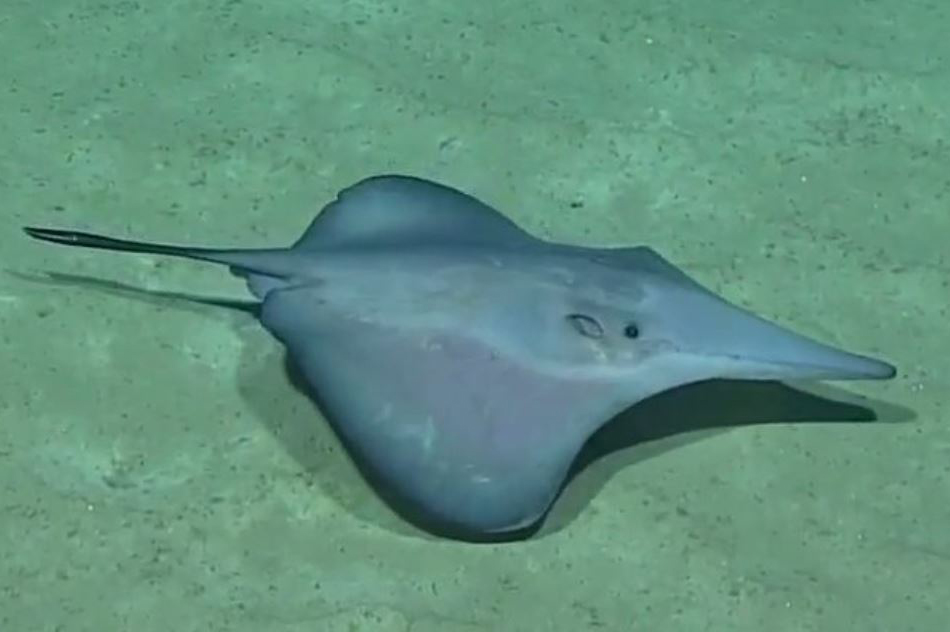Sixgill Stingray, Hexatrygon bickelli Heemstra & Smith 1980

A Sixgill Stingray, Hexatrygon bickelli, filmed by an ROV on the Musicians Seamounts in the Central Pacific, September 2017. Source: NOAA Office of Ocean Exploration and Research, Deep-Sea Symphony: Exploring the Musicians Seamounts. License: CC by Attribution
Summary:
A soft, extremely flabby stingray with a heart-shape disc, a broad-based, long and triangular snout, small widely-spaced eyes positioned well before the spiracles, 6 widely separate pairs of small gill slits, and the tail much shorter than the disc with 1 or 2 stings. The Sixgill Stingray has a smooth body with no denticles.
Video of a Sixgill Stingray filmed by an ROV on the Musicians Seamounts in the Central Pacific.
Video of a male Sixgill Stingray filmed on the Musicians Seamounts in the Central Pacific.
Video of a Sixgill Stingray filmed by an ROV on the Musicians Seamounts in the Central Pacific.
Video of a male Sixgill Stingray filmed on the Musicians Seamounts in the Central Pacific.
Cite this page as:
Bray, D.J. 2023, Hexatrygon bickelli in Fishes of Australia, accessed 26 Apr 2024, https://fishesofaustralia.net.au/home/species/3596
Sixgill Stingray, Hexatrygon bickelli Heemstra & Smith 1980
More Info
|
Distribution |
Off Flinders Reef, Queensland Plateau, Coral Sea, and off Shark Bay to the Exmouth Plateau, Western Australia. Elsewhere the species is widespread with a patchy distribution on continental slopes and seamounts in the Indo-west-central Pacific in depths to 1120 m. |
|
Colour |
Purplish brown dorsally and white below with a dusky margin on disc and pelvic fins, a the underside of the tail dark. |
|
Biology |
Viviparous. Males mature at about 110 cm TL, and females at about 113 cm TL; size at birth about 48 cm TL. |
|
Fisheries |
Taken infrequently in bottom trawl fisheries. |
|
Etymology |
The species is named in honour of Dave Bickell, a former journalist for the Eastern Province Herald, South Africa, who discovered the holotype washed ashore on the beach at Port Elizabeth. |
|
Species Citation |
Hexatrygon bickelli Heemstra & Smith 1980, Ichthyol. Bull. J.L.B. Smith Inst., Grahamstown 43: 6, figs 1-13, 15. Type locality: beach at Port Elizabeth, South Africa. |
|
Author |
Bray, D.J. 2023 |
|
Resources |
Sixgill Stingray, Hexatrygon bickelli Heemstra & Smith 1980
References
Babu, C., Ramachandran, S. and Varghese, B.C. 2011. New record of sixgill sting ray Hexatrygon bickelli Heemstra and Smith, 1980 from south-west cost of India. Indian Journal of Fisheries 58: 137-139.
Compagno, L.J.V. & Last, P.R. 1999. Family Hexatrygonidae. pp. 1477-2478 in Carpenter, K.E. & Niem, V.H. (eds). The Living Marine Resources of the Western Central Pacific. FAO Species Identification Guide for Fisheries Purposes. Rome : FAO Vol. 3 pp. 1397-2068.
Daley, R.K., Stevens, J.D., Last, P.R. & Yearsley, G.K. 2002. Field Guide to Australian Sharks & Rays. Hobart : CSIRO Marine Research 84 pp.
Heemstra, P.C. & Smith, M.M. 1980. Hexatrygonidae, a new family of stingrays (Myliobatiformes: Batoidea) from South Africa, with comments on the classification of batoid fishes. Ichthyological Bulletin of the J.L.B. Smith Institute, Grahamstown 43: 1-17 http://hdl.handle.net/10962/d1019701, ISBN 0-86810-038-2
Last, P.R. & Stevens, J.D. 1994. Sharks and Rays of Australia. Canberra : CSIRO Australia 513 pp. 84 pls.
Last, P.R. & Stevens, J.D. 2009. Sharks and Rays of Australia. Collingwood : CSIRO Publishing Australia 2, 550 pp.
McCormack, C., Wang, Y., Ishihara, H., Fahmi, Manjaji Matsumoto, B.M., Capuli, E. & Orlov, A. 2015. Hexatrygon bickelli. The IUCN Red List of Threatened Species 2015: e.T161674A68626659. http://dx.doi.org/10.2305/IUCN.UK.2015-4.RLTS.T161674A68626659.en. Downloaded on 05 October 2017.
Séret, B. & de Carvalho, M.R. 2016. 23. Sixgill Stingrays. Family Hexatrygonidae. pp. 509-510 in Last, P.R., White, W.T., Carvalho, M.R. de, Séret, B., Stehmann, M.F.W. & Naylor, G.J.P. (eds.) Rays of the World. Clayton South, Victoria : CSIRO Publishing 790 pp.
Weigmann, S. 2016. Annotated checklist of the living sharks, batoids and chimaeras (Chondrichthyes) of the world, with a focus on biogeographical diversity. Journal of Fish Biology 88(3): 837-1037
White, W.T., Baje, L., Sabub, B., Appleyard, S.A., Pogonoski, J.J. & Mana, R.R. 2018. Sharks and Rays of Papua New Guinea. Australian Centre for International Agricultural Research (ACIAR) Monograph No. 189: i-vi, 1-327.





